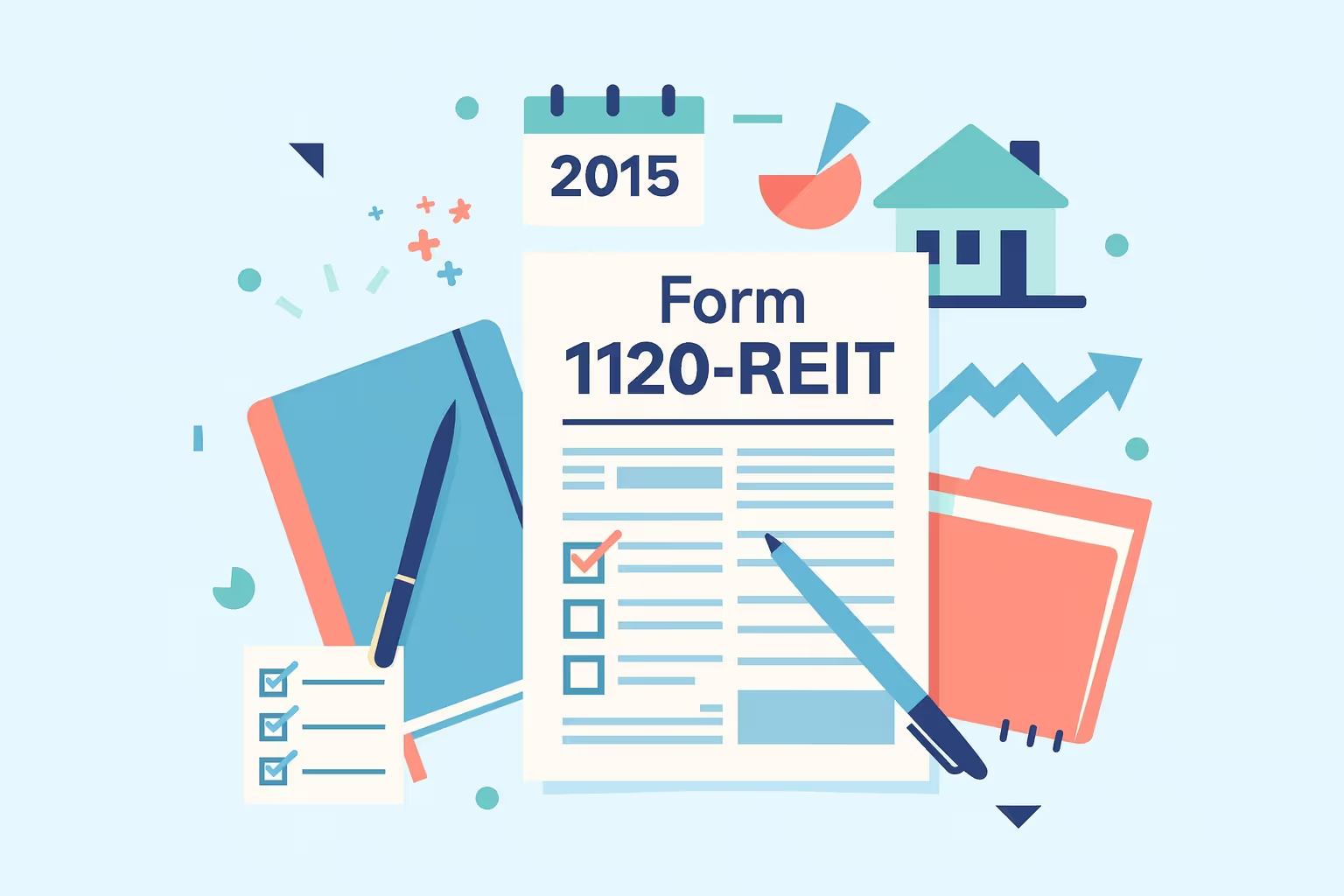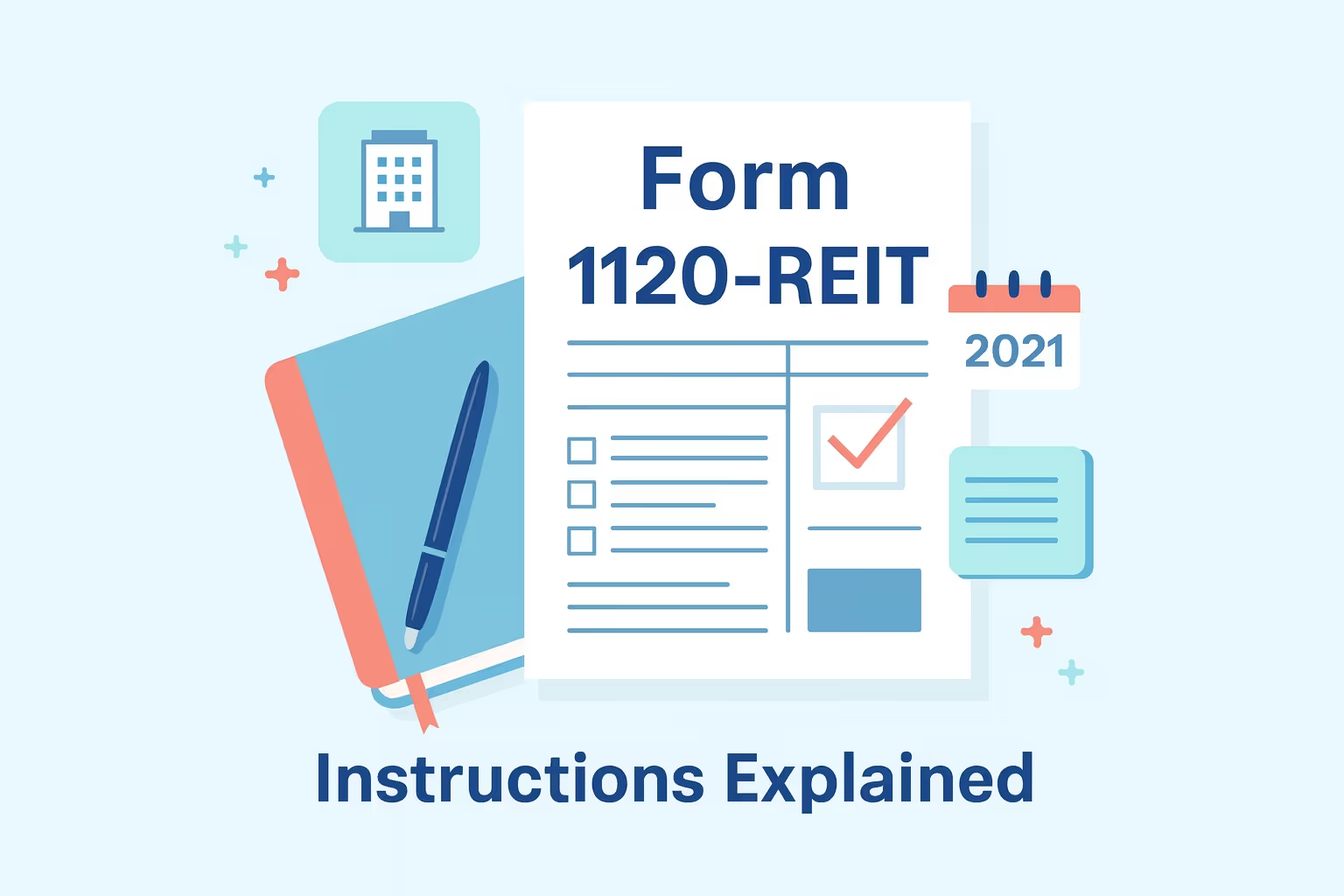
Real estate investment trusts play a unique role in the federal tax system. They offer investors access to property-based earnings while also carrying specific tax obligations. These entities must carefully manage income reporting, deductions, and shareholder distributions to maintain their REIT status and receive favorable tax treatment under the Internal Revenue Service rules.
For the 2017 tax year, filing Form 1120-REIT was a critical requirement. This income tax return reported taxable income, REIT dividends, capital gains, ordinary income, and deductions while ensuring compliance with REIT qualification tests. The IRS forms associated with this filing helped corporations accurately calculate corporate income taxes, excise tax, and other tax liabilities tied to real estate investment.
Whether focused on equity or mortgage REITs, REIT investors rely on these filings to confirm accurate dividend reporting and regulatory compliance. The form affects how distributions, including ordinary dividends and potential return of capital, are taxed at the shareholder level. This guide explains the process, breaks down the sections, and highlights steps that reduce penalties and errors when filing an income tax return.
Form 1120-REIT at a Glance
Understanding the purpose of Form 1120-REIT is essential for any corporation that qualifies as a real estate investment trust. The return for real estate entities differs significantly from a standard corporate tax return because it reflects specialized tax treatment and strict distribution requirements for REIT investors.
What Form 1120-REIT Covers
- Reports taxable income: The form documents profit, ordinary income, REIT dividends, capital gains, and other earnings subject to corporate income taxes.
- Calculates tax liability: REITs use the form to determine their income tax liability, excise tax, and any additional payments or penalties owed to the IRS.
- Documents REIT status: Entities file annually to demonstrate they qualify for REIT taxation and remain exempt from certain corporate income taxes if requirements are met.
- Shows distributions: Form 1120-REIT records dividends and any return of capital distributed to shareholders, ensuring investors are taxed correctly on earnings or nontaxable return amounts.
Who Must File for 2017
- Corporations electing REIT status: Any corporation treated as a real estate investment trust under IRS forms and rules must file for the applicable tax year.
- Entities with taxable income: REITs generating profit, dividends, or capital gains taxes must submit an income tax return to report income accurately.
- Dormant or low-activity REITs: Even with minimal property income, REITs invest in assets that require annual reporting to maintain compliance and exemption from standard taxation.
Key Parts and Core Schedules
- Part I: This part focuses on ordinary income, taxable income, depreciation, expenses, wages, and deductions that reduce overall tax liability.
- Part II: This part calculates tax on foreclosure property, capturing earnings when real estate investment assets are eventually sold under special conditions.
- Part III: This part covers penalties for income test failures and reporting excess non-qualifying income that increases the REIT’s tax burden.
- Schedules A, J, and K: These schedules handle dividends paid, tax computation, and compliance reporting, which are central to the income tax return process.
What Changed for 2017
The 2017 tax year brought adjustments that affected how REITs completed Form 1120-REIT. These included statutory updates, new income reporting lines, and altered filing instructions. Each change influenced how real estate investment trust entities calculated tax liability and reported REIT dividends or capital gains.
TCJA Transition Effects for Fiscal-Year Filers
- Blended tax rate rules: Certain corporations were subject to modified tax rate calculations, affecting REITs that needed to pay corporate income taxes across fiscal periods.
- Entertainment expense restrictions: Deductions for entertainment expenses were eliminated after 2017, narrowing the range of costs that REITs can invest in related corporations and deduct.
New or Revised Lines and Definitions in 2017
- Hedging transactions reporting: New lines required REITs to report income and interest from hedging under updated IRS instructions and REIT status requirements.
- Foreign exchange gains: Expanded line items tracked income excluded from passive foreign exchange gains, ensuring correct cost basis and tax treatment.
Disaster Relief and Service-Center Address Updates
- Disaster-area provisions: REITs in regions affected by natural disasters received tax benefits, including extended deadlines and deductions for qualified contributions.
- Filing address changes: IRS forms updated filing centers for certain states, altering where corporations had to file their income tax return and supporting schedules.
Pre-Filing Preparation
Before completing Form 1120-REIT, entities must verify eligibility and organize financial accounts. Proper preparation reduces errors, minimizes penalties, and ensures REIT investors can rely on accurate reporting for dividends, distributions, and return of capital.
Confirm Your Filing Requirement and Status
- Election of REIT status: A corporation must have elected to qualify as a real estate investment trust and maintained eligibility throughout the tax year.
- Ongoing obligations: Even entities with exempt or reduced liability must file if they have property holdings, income, or expenses that affect taxable income.
Gather Documents, Ledgers, and Support
- Financial statements: REITs must provide accurate reports of capital, profit, wages, depreciation, expenses, and account balances for the IRS income tax return.
- Transaction records: Dividend payments, interest earned, property sales, and capital gains taxes require thorough documentation to support the tax return filed.
Set Up Accounting, Ownership, and Distribution Records
- Ownership tracking: Accurate shareholder records help confirm REIT qualification requirements and ensure ordinary dividends and return of capital distributions are reported.
- Distribution planning: Entities must document REIT dividends and income distributions to meet the 90% payout requirement and reduce overall tax burden.
Step-by-Step Completion of Form 1120-REIT
Completing the form involves methodically addressing each section in sequence. Following these steps ensures that the REIT’s income, deductions, capital gains, and distributions are reported properly and that tax obligations are met without unnecessary penalties.
Step 1: Provide Entity and Header Information
Include the corporation name, address, Employer Identification Number, tax year, and type of REIT. This section establishes REIT status and aligns the return for real estate with IRS records.
Step 2: Report Income in Part I
Document dividends, capital gains, rents, property sales, and interest. Include ordinary and taxable income sources to calculate preliminary tax liability on the income tax return.
Step 3: Record Deductions and Expenses
Enter depreciation, wages, advertising, interest, and other allowable deductions. These expenses reduce taxable income and lower the income tax liability that the REIT must eventually pay.
Step 4: Adjust for Special Taxes in Parts II–IV
Report foreclosure property income, penalties for failing REIT income tests, and prohibited transaction income. These adjustments ensure corporate income tax and excise taxes are properly calculated.
Step 5: Complete Schedules for Distributions and Computation
Use Schedule A to report REIT dividends and distributions, Schedule J for tax computation, and Schedule K for compliance questions. These schedules finalize tax treatment of profits, dividends, and liabilities.
Required Schedules and Attachments
Form 1120-REIT requires multiple schedules to confirm income, deductions, and compliance with REIT qualification tests. These schedules ensure the Internal Revenue Service has the details to verify distributions, taxable income, and overall tax liability for the tax year.
Schedule A — Dividends Paid Deduction
Schedule A records all dividends paid during the tax year, including ordinary dividends, return of capital distributions, and REIT dividends. It calculates the allowable deduction and includes late-year payments treated as current. This schedule also verifies compliance with the 90% distribution requirement to maintain REIT status.
Schedule J — Tax Computation and Credits
Schedule J determines the final tax liability by combining taxable income, capital gains, and excise tax obligations. It applies the correct corporate tax rate and includes adjustments for special REIT penalties. It also accounts for prior payments and available credits, reducing the overall tax liability reported to the Internal Revenue Service.
Schedules K, L, and M-1/M-2
These schedules provide detailed compliance and financial information. Schedule K addresses foreign ownership and entity structure. Schedule L reports assets, liabilities, and capital balances for the beginning and end of the year. Schedules M-1 and M-2 reconcile book income with taxable income and track retained earnings, ensuring consistent and accurate REIT reporting.
Additional Forms Triggered by REIT Activity
- Capital transactions: Schedule D and Form 4797 capture capital gains and losses when property or apartment complexes are eventually sold.
- Depreciation reporting: Form 4562 documents depreciation deductions tied to real estate investment and property holdings.
- International compliance: Forms 5471, 926, and 1118 may be required if REITs invest abroad or claim foreign tax benefits.
Filing Methods and Return Assembly
REITs must choose between e-file and paper filing depending on asset size, filing volume, and IRS form requirements. Regardless of method, assembling the tax return correctly ensures timely processing and reduces penalties.
E-File Eligibility, Advantages, and Triggers
- Electronic filing requirement: Entities with $10 million or more in assets and at least 250 returns must e-file Form 1120-REIT.
- Processing speed: E-filed returns are processed faster, reducing delays for REIT investors and reducing payment posting errors.
- Error reduction: IRS forms with built-in validation help avoid incorrect taxable income or distribution entries.
Paper Filing, Addresses, and Private Delivery Services
- Filing addresses: The address depends on the principal business location, tax year, and whether assets exceed $10 million.
- Private services: IRS accepts certain private delivery services for timely filing, ensuring compliance for entities holding REIT filers nationwide.
- Assembly order: Must follow IRS instructions to avoid delays, beginning with Form 1120-REIT and including all schedules, attachments, and signed authorizations.
Assembly Order, Signature Rules, and Preparer Sections
- Signatures: Must be signed by an authorized corporation officer to validate the income tax return.
- Preparer information: Paid preparers must complete required details or risk penalties under IRS regulations.
- Return copies: Corporations should retain copies of all schedules, deductions, distributions, and supporting documents for tax year records.
Payments, Extensions, and Estimated Tax
Meeting payment deadlines is essential for avoiding penalties and interest. REITs must use approved electronic methods to pay corporate income taxes, excise tax, or other obligations tied to taxable income.
Due Dates and Extension with Form 7004
Calendar-year REITs must file by April 15, unless the deadline falls on a weekend or holiday. Fiscal year REITs file on the fifteenth day of the fourth month after the year ends, with a special rule for June 30 year-ends. Form 7004 provides a six-month extension to file, though it does not extend tax payments.
Electronic Payment Methods and EFTPS
The Electronic Federal Tax Payment System is required for final payments, estimated payments, and deposits of excise or withheld taxes. Payments must be scheduled by 8 p.m. Eastern time the day before the deadline. Same-day wire transfers are also available if deadlines are missed, but they require advance setup with financial institutions.
Quarterly Estimates and Safe Harbors
Estimated tax payments are required if the REIT expects a liability of at least $500 during the tax year. Quarterly deadlines generally fall in April, June, September, and December. To avoid penalties, REITs must pay either 100% of the prior year’s or 90% of the current year’s liability.
REIT Qualification Tests — Quick Reference
Maintaining REIT status requires meeting organizational, asset, income, and distribution requirements. Failure to meet these tests can result in additional taxes, excise tax, or loss of REIT eligibility.
Asset Tests and Quarterly Monitoring
- 75% asset test: At least 75% of assets must be real estate investment property, mortgages, or government securities.
- 20% TRS limit: No more than 20% of total assets can be held in taxable REIT subsidiaries, ensuring focus on real estate investment.
- 5% single entity rule: REITs cannot hold more than 5% of assets in securities of one non-REIT corporation.
Income Tests and Annual Percentages
- 95% income test: At least 95% of income must come from qualifying sources, including REIT dividends, rents, interest, and capital gains.
- 75% income test: At least 75% of income must derive from real estate investment activities, such as property rents and mortgage interest.
- Exclusions: Certain foreign and prohibited transaction income is excluded from the tests.
Distribution Requirement and Year-End Timing
- 90% payout rule: REITs must distribute at least 90% of taxable income to shareholders, typically through ordinary dividends or capital gains dividends.
- Timing exception: Dividends declared in October through December can be treated as paid in that tax year if distributed by January 31.
- Noncompliance risk: Failure to meet distribution rules subjects the REIT to excise tax and potential loss of tax benefits.
Taxable REIT Subsidiaries (TRS) and Related-Party Rules
Taxable REIT subsidiaries allow REITs to provide services or hold assets that would otherwise disqualify income under REIT rules. These entities carry unique tax treatment and must follow IRS forms and reporting requirements to avoid penalties or excise tax exposure.
What a TRS Can Do Without Jeopardizing Qualification
- Service provision: TRS entities may provide non-customary tenant services that would otherwise disqualify rental income, preserving the REIT’s ordinary income classification.
- Asset flexibility: TRS subsidiaries allow REITs to diversify into investments or property activities that equity REITs cannot directly hold without losing exempt status.
- Business operations: Using TRS entities, REITs invest in activities such as property management or ancillary businesses while maintaining REIT status for tax year reporting.
Arm’s-Length Standards and the 100% Prohibited-Benefit Tax
- Transfer pricing rules: All transactions between a REIT and its TRS must follow arm’s-length standards, preventing disguised distributions or reduced tax liability.
- 100% penalty tax: If benefits are improperly shifted, the Internal Revenue Service can impose a 100% tax on prohibited income, increasing the REIT’s tax burden.
- Interest deductions: Interest paid by TRS entities to the parent REIT may face limitations to prevent excessive deductions and reduce taxable corporate income.
Common Mistakes and Audit Flags
Errors in reporting capital gains, dividends, and distributions are among the most frequent reasons REITs face penalties. The Internal Revenue Service closely reviews income tax returns for signs of misreporting or noncompliance with REIT qualification tests.
Income Classification and Capital Gain Reporting Errors
- Misreporting gains: Treating ordinary income as capital gains or failing to report cost basis adjustments can result in an understated tax liability.
- Rental income errors: Classifying non-qualifying rental income as exempt may trigger additional corporate income taxes and penalties.
- Incorrect depreciation: Inconsistent depreciation schedules distort taxable income and increase the risk of adjustments during audit.
Distribution Timing and Excise Tax Risks
- Late dividend declarations: Declaring REIT dividends after deadlines may disqualify them from current tax year distributions, increasing the REIT’s excise tax liability.
- Failure of 90% rule: Distributing less than 90% of taxable income subjects the REIT to excise tax and can jeopardize REIT status.
- Improper reporting: Incorrectly treating return of capital distributions as dividends inflates taxable income and creates errors for REIT investors.
Missing Schedules and Documentation Gaps
- Omitted attachments: Missing required schedules or IRS forms delay processing and increase penalties for late or incomplete filing.
- Ownership records: Failure to maintain accurate shareholder account records undermines REIT qualification and income tax return compliance.
- Assembly errors: Incorrect filing order or unsigned forms invalidate the return for real estate corporations.
Zero-Activity or Dormant Year Filers
REITs must file an income tax return to confirm REIT status even when income is minimal. Holding REITs during a dormant year requires reporting assets, expenses, and shareholder distributions, even if taxable income is low or exempt.
When a Dormant REIT Still Must File
- Election made: Entities that elected REIT status in a prior tax year must file until the election is revoked or the corporation dissolves.
- Minimal income: Even without capital gains or ordinary income, REITs must report assets, property, and deductions to maintain compliance.
Special Considerations for Dormant REITs
- Net operating losses: Losses generated can be carried forward to reduce future tax liability, creating long-term tax benefits for REIT investors.
- Distribution requirements: If taxable income is zero, no distribution is needed, but REITs must document shareholder accounts and exempt status.
After Filing — Amendments, Notices, and Records
After filing Form 1120-REIT, corporations may need to amend, respond to IRS notices, or maintain records for audit purposes. Careful retention protects against disputes and confirms compliance with corporate income taxes.
Amended Returns, Consent and Deficiency Dividends
- Amended filing: REITs must file an amended Form 1120-REIT with clear explanations and corrected schedules if errors are found.
- Consent dividends allow shareholders to be taxed on undistributed earnings, reduce excise tax, and maintain REIT status.
- Deficiency dividends: Used to correct under-distribution, these require IRS approval and a timely Form 976 submission.
Recordkeeping and Retention Requirements
- Retention period: Maintain tax return copies, account records, and IRS forms for at least three years after filing, or longer for assets subject to depreciation.
- Ownership certifications: Keep shareholder lists and documentation to prove compliance with 100-shareholder and closely-held tests.
- Transaction support: Preserve evidence for dividends, interest, property sales, and REIT shares distributions to defend against adjustments.
Final Compliance Checklist
REITs should review key items before submission to avoid penalties or delays. A checklist confirms that all requirements are met, reducing the risk of additional taxes or Internal Revenue Service notices.
Pre-Submission Checklist Items
- Eligibility confirmed: Entity qualifies as a REIT and meets asset, income, and distribution requirements.
- Form review: All schedules, deductions, dividends, and distributions are accurately reported.
- Signatures complete: Authorized officers and paid preparers have signed where required.
Post-Filing Follow-Up Tasks
- Payment verified: Corporate income taxes, excise tax, and penalties are fully paid through approved electronic methods.
- Recordkeeping secured: Copies of all filings and supporting documents are retained for the required tax year period.
- Monitoring systems: Internal processes are established to track distributions, REIT shares, and cost basis for future compliance.
Frequently Asked Questions
When is Form 1120-REIT due for the 2017 tax year?
Form 1120-REIT is due on the fifteenth day of the fourth month following the end of the tax year. For calendar-year filers, the deadline was April 15, 2018. If the date fell on a weekend or holiday, the due date shifted to the next business day, consistent with Internal Revenue Service guidance.
Do REITs have to e-file or can they file a paper income tax return?
E-filing is required for REITs with at least $10 million in assets and more than 250 annual IRS forms filed. Smaller corporations may file a paper return for real estate reporting. However, electronic filing is generally recommended because it reduces processing errors, accelerates refunds, and ensures compliance with Internal Revenue Service expectations.
How are REIT dividends and return of capital distributions reported to shareholders?
Ordinary and REIT dividends are reported as taxable income to investors, while return of capital is a nontaxable return that reduces cost basis. Shareholders must track these amounts carefully since distributions eventually affect capital gains taxes when selling REIT shares. Proper reporting ensures investors understand the tax treatment for each dividend type.
What are the main tax benefits of holding REITs for investors?
Holding REITs provides higher yields, steady dividends, and tax benefits tied to pass-through taxation. Since REITs distribute at least 90% of taxable income, investors avoid the double taxation many corporations face. Although ordinary income distributions are subject to income tax, REIT investors benefit from long-term appreciation and reduced corporate income taxes at the entity level.
How are capital gains and ordinary income treated differently for REITs?
Capital gains are taxed at applicable capital gains taxes when property or REIT shares are sold, while ordinary income is subject to regular tax rates. REITs report both on Form 1120-REIT. Shareholders must account for cost basis adjustments to determine profit or loss, ensuring proper income tax treatment across different earnings categories.
What penalties apply if a REIT fails to file or pay corporate income taxes on time?
Failure to file results in penalties based on taxable income and tax liability, with a minimum penalty for returns filed over sixty days late. Failure to pay incurs monthly penalties until taxes are satisfied. The Internal Revenue Service also charges interest on unpaid balances, and additional penalties may apply for failing REIT qualification or distribution requirements.
Can a dormant REIT with no taxable income still face tax obligations?
A dormant REIT must file Form 1120-REIT to maintain REIT status, even with no taxable income or distributions. While no excise or corporate income taxes are owed when taxable income is zero, the entity must keep ownership records, asset documentation, and account statements. Filing demonstrates compliance and preserves future eligibility for real estate investment activities.



































